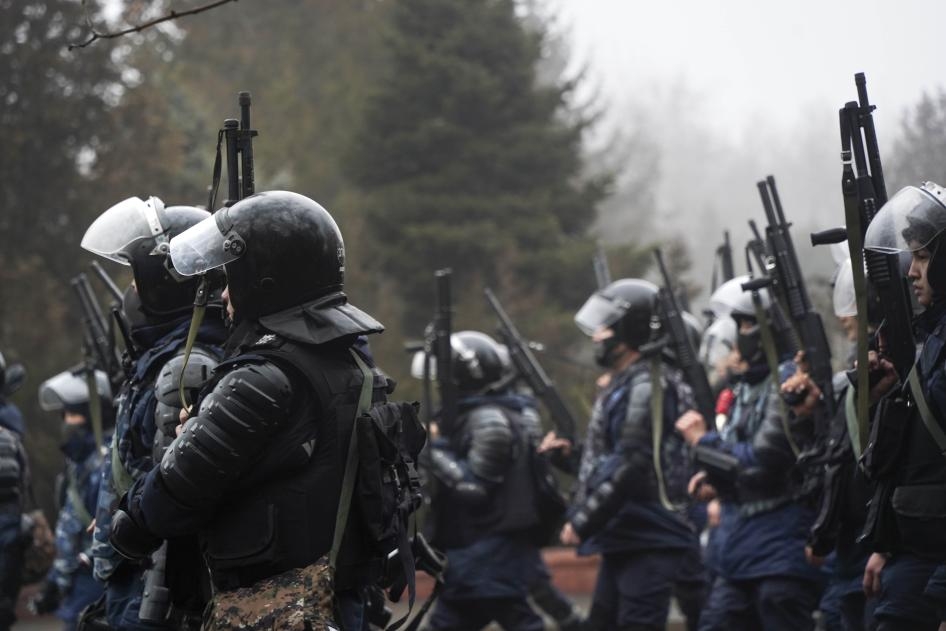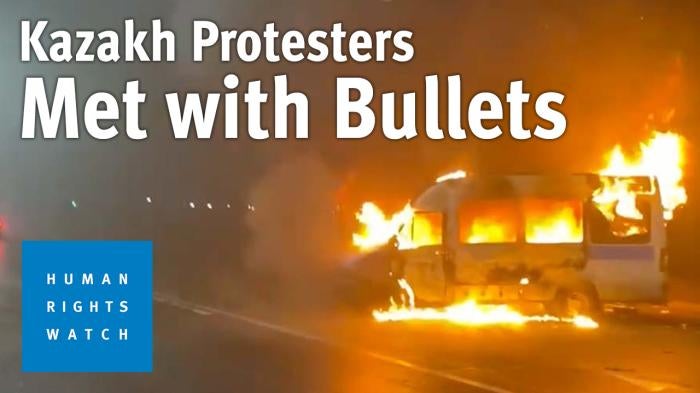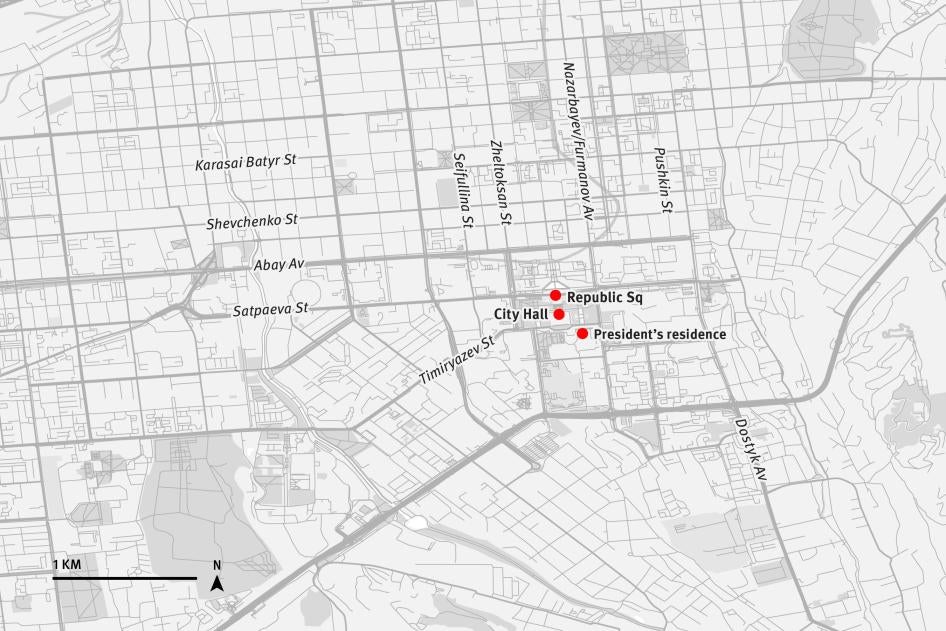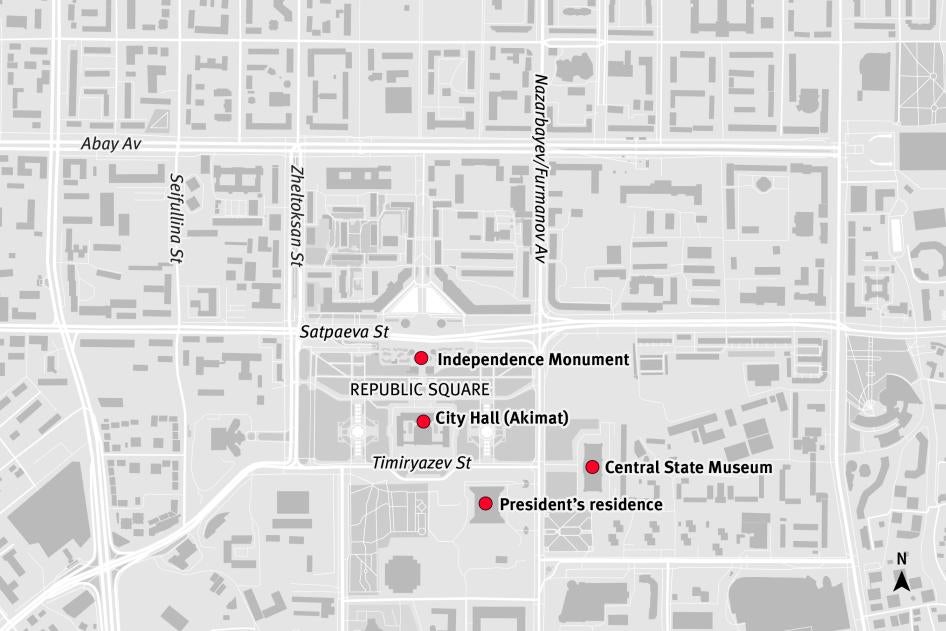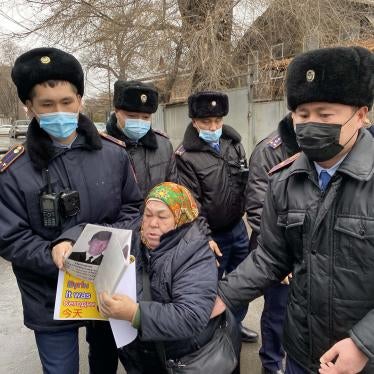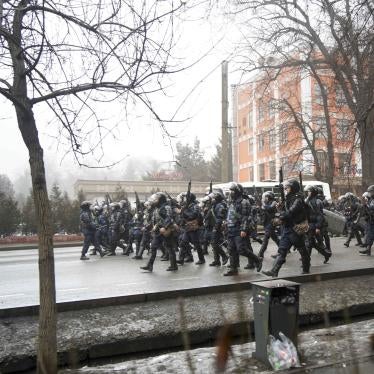Correction (January 31, 2022): An earlier version stated the Interior Ministry had reported the death of 19 members of the security forces in a statement published during the night of January 5 to 6. It was first reported by media on January 7 and this report was corrected to reflect this.
(Berlin) – Kazakh security forces used excessive force on at least four occasions, including lethal force such as shooting at protesters and rioters, during recent demonstrations and subsequent civil unrest, Human Rights Watch said today. An analysis of over 80 verified videos recorded between January 4 and 6, 2022, in Almaty, Kazakhstan’s largest city, highlights the urgent need for an effective, independent, and impartial investigation.
The worst of the four incidents analyzed in the videos led to 10 apparent killings, with 19 people injured. The full toll is likely higher, both in this case and in others in which security forces used excessive force. On January 15 Kazakhstan’s prosecutor’s office stated that the bodies of 225 people, including 19 members of the security forces, had been delivered to morgues across the country since January 4.
“There is ample evidence showing that security forces opened fire without any apparent justification and killed at least 10 people,” said Jonathan Pedneault, conflict and crisis researcher at Human Rights Watch. “The death toll from the violent crackdown is likely much greater and requires a prompt and effective investigation.”
Protests began on January 2 in Zhanaozen, a western oil town, over a sharp increase in gas prices. By January 4, thousands of peaceful protesters in other parts of the country had joined in, demanding economic and political reforms. The government clamped down on the protests over the next six days, including restrictions to internet access. Authorities in Kazakhstan have long restricted fundamental rights and rejected calls for genuine reforms.
Human Rights Watch verified and analyzed over 80 videos, the majority of which were recorded by participants or witnesses to the events in Almaty between January 4 and 6 and shared on Telegram, Twitter, Facebook, or YouTube. Nine of them were recorded by Agence France-Presse journalists and one was posted online by the Kazakh government. A local journalist sent another video directly to Human Rights Watch.
By matching landmarks in the videos with satellite imagery, maps, and photographs, Human Rights Watch identified the locations where the videos were recorded. To establish a chronology, footage was compared with media reports and social media posts, the time of sunset and sunrise, and clocks shown in recordings. For the events on January 6, Human Rights Watch also spoke with three witnesses, a journalist and two protesters.
In the first incident, 17 videos recorded on late January 4 and early January 5 show peaceful protesters walking to and gathering in Almaty’s Republic Square, close to city hall and the president’s palace. Small groups within the crowd appear to be looting from stores on their way to the square. Around 12:15 a.m., shortly after the protesters arrived, security forces forcibly dispersed them with teargas, stun grenades, and rubber projectiles. Afterward, a crowd began to attack security forces and set fire to police vehicles.
In the second incident, a series of 23 videos recorded between 3 and 5:30 p.m. on January 5, shows that security forces protecting the president’s residence repeatedly fired with assault rifles at several hundred people outside the building, including protesters and others holding sticks, shields, and spades. The people did not appear to be posing an imminent threat to security forces, though one person might have been holding a handgun. From this footage, Human Rights Watch counted at least 10 people who appear to have been killed and 19 injured, most of them apparently by bullets.
That night, in a televised speech, President Kasym-Jomart Tokaev referred to the protesters and rioters as “terrorist gangs […] who have undergone training abroad.” He did not elaborate or offer evidence for his claims at the time, or since.
In the third incident, a video showed soldiers shooting live ammunition in Republic Square around 10 a.m. on January 6. A protester who was present at the time said that she and about 150 others were peaceful and shouted “Don’t shoot” prior to security forces firing into the air. She said one man was injured, which local media also reported.
In the fourth incident, between 6 and 6:30 p.m. on January 6, peaceful protesters again gathered on Republic Square holding a large white banner that read: “We are peaceful protesters! We are not the terrorists!”
A protester present at the time told Human Rights Watch that he saw security forces fire warning shots prior to directing live fire at the protesters and then ran for his life. The protester who was on the square earlier and the journalist said they had left the square minutes before but heard the shooting. Witnesses who spoke to the journalist said they saw one protester hit in the head and another wounded in the upper body.
The witness accounts are consistent with footage in six videos that were recorded at the time by people who were fleeing or hiding from the shooting, though none of them captured video of the soldiers opening fire. In one, over 100 gunfire rounds can be heard. One video showed one man, apparently injured, being carried by protesters to a car.
During a televised speech on January 7, President Tokaev said he had ordered security forces “to shoot to kill without warning.” The same day, Human Rights Watch urged the government to rescind the order because it could lead to unlawful killings.
The government has subsequently defended the conduct of security forces. On January 16 the Almaty police chief, Kanat Taimerdenov, told the media that “in all cases, police officers worked according to the established procedures to ensure the protection of public order during peaceful assemblies and were not armed.” On January 11 Almaty police said that, in addition to the 19 killed, 176 of its officers had been injured in the unrest.
In addition to obligations to protect rights to life and bodily integrity, under international human rights law, Kazakhstan has an obligation to respect the right to peaceful expression and assembly, including by ensuring that its security forces are trained and equipped to police demonstrations in rights-respecting ways.
The United Nations Basic Principles on the Use of Force and Firearms by Law Enforcement Officials state that security forces should “apply non-violent means before resorting to the use of force and firearms,” and use the minimum necessary force at all times. Intentional, lethal use of firearms is only permitted when strictly unavoidable to protect life.
In light of the gravity of the alleged violations, Kazakhstan’s international partners, including the UN, the Organization for Security and Cooperation in Europe (OSCE), of which Kazakhstan is a member, and the European Union, should press the government of Kazakhstan to conduct an effective, independent and impartial investigation into the security forces’ response to the January events, with a view to ensuring full accountability.
The government should also conduct an effective investigation to identify those responsible for attacking and killing security force members, causing criminal damage to public property, or other unlawful acts. They should be held to account in fair proceedings, Human Rights Watch said.
The government should seek the support of international expertise and refrain from hindering inquiries and monitoring activities by national and international non-governmental groups, regional and international organizations, and the media.
Should the government fail to conduct an effective investigation that meets international standards, OSCE members should invoke the Moscow Mechanism, an OSCE investigation procedure, and UN Human Rights Council members should address the issues at their next session.
“Dozens of grieving families across Kazakhstan are waiting for answers from their government,” Pedneault said. “It should be a priority for Kazakhstan to restore some measure of confidence in the rule of law and ensure that all those responsible for this tragic loss of life are held to account.”
For additional details, please see below.
The following chronology is based on a review of over 80 verified videos that were recorded in Almaty between January 4 and 6, the majority of which were shared on Telegram, Twitter, Facebook, or YouTube, the remainder filmed by journalists. Together with statements provided by three witnesses and media reports, they show that security forces forcibly dispersed peaceful protesters on the night of January 4 and early morning of January 5, and used lethal force on January 5 and 6, resulting in serious injuries and deaths.
Late January 4 and Early January 5 – Incident One
Human Rights Watch analyzed 17 videos recorded in Almaty on late January 4 and early January 5 that show the Kazakh security forces’ unlawful dispersal of peaceful protests, including using unnecessary and disproportionate force, while a shutdown of mobile internet access was being imposed.
Peaceful Demonstrations
A video from AFP, made up of multiple clips recorded around 12 p.m. on January 4, shows a small group of peaceful protesters led by Zhanbolat Mamay, a former journalist now leading Kazakhstan’s unregistered Democratic Party, rallying in support of the protest movement on Almaty’s Republic Square. Security forces are then seen arriving and appear to order them to disperse.
Around 6:30 p.m., users and media began to report restrictions to mobile internet access, which represents almost 75 percent of online traffic in Kazakhstan. Between 7:15 and 7:45 p.m., as media reports describe and a video posted to Telegram show, scores of peaceful protesters gathered by Alatau Theater on the outskirts of Almaty, heading toward the center, 10 kilometers away. At around 10 p.m., a group of thousands of protesters is seen in a video posted to Facebook walking toward central Almaty, singing the national anthem.
Security Forces on Republic Square
Human Rights Watch verified three videos shared on YouTube and Telegram showing hundreds of law enforcement officers equipped with riot gear, including shields, helmets, and batons, deploying by midnight on the night of January 4 on Republic Square. Before protesters arrived, the forces are seen forming a cordon blocking the entrance to city hall and positioning themselves at the crossroads of Satpaev and Nazarbayev Streets, on the eastern end of the square. Seven transport trucks and at least 33 police vans support them.
Between 12:05 and 12:19 a.m. on January 5, peaceful protesters can be seen filling Republic Square, entering from the west at the crossroads of Satpaev and Zheltoksan Streets, and gathering around the Independence monument.
Forced Dispersal of Peaceful Protesters; Unnecessary Use of Force
Fifteen minutes after the peaceful demonstrators arrived, about 20 distant detonations are heard in a video recorded from a building overlooking Republic Square from the north. Several hundred additional protesters are then seen arriving from Zheltoksan Street, rushing toward the police cordon in front of city hall and pushing their way through the line. The protesters eventually flanked law enforcement officials, who then retreated east to their position at the corner of Satpaev and Nazarbayev Streets. Within minutes, a series of loud detonations are heard, and a thick cloud of teargas smoke can be seen wafting westward from the law enforcement position, slowly engulfing the square and protesters.
Between approximately 12:25 and 12:51 a.m., law enforcement officers at the corner of Satpaev and Nazarbayev Streets deployed scores of stun grenades and teargas canisters to disperse the crowd. A video posted to Telegram shows that some protesters retaliated by throwing stones and other objects at law enforcement officers, but most protesters remained peaceful.
Tokaev Speech, Rioting, and Retreat by Security Forces
Just as security forces were forcefully dispersing protesters from Republic Square, President Tokaev gave a televised speech, broadcast shortly before 12:37 a.m., in which he called for dialogue but emphasized that the government would not fall and that “calls to attack the offices of civil and military departments are absolutely illegal.”
By 1:05 a.m., law enforcement officials had dispersed all protesters from Republic Square, but violence erupted in other areas of town, with groups of rioters aggressively targeting police vehicles and setting them on fire.
Around 2 a.m., a video recorded near Republic Square and posted on YouTube showed security forces aggressively confronting a group of protesters who appeared largely peaceful, except for some people throwing stones. The video showed security forces firing stun grenades and a policeman hitting one detainee in the back.
Two videos of an incident that took place before 2:53 a.m. about 700 meters northwest of Independence Monument, near the corner Seifullin and Abay Streets, show hundreds of rioters chasing away security forces aboard three troop-carrying trucks and an 8-wheeled BTR armored vehicle with a mounted machine gun.
January 5 and Early January 6
Human Rights Watch analyzed over 50 videos recorded between the late afternoon of January 5 and early morning January 6 that show government forces adopting different security postures at various points, beginning with a show of force, followed by a deployment of unarmed and lightly equipped troops on foot in the streets of Almaty, only hours after people had clashed with security forces.
At 3 p.m., a mixed group of protesters and rioters tried to storm government buildings, including the Almaty city hall and the nearby president’s residence.
Law enforcement officers defending city hall appeared to offer limited resistance, with some security force personnel captured and severely beaten. But cadets and police officers deployed at the residence rapidly resorted to sustained and excessive lethal force. In footage from the event, Human Rights Watch identified at least 19 people who were injured and 10 who appear to have been killed.
Early Morning Deployment of Forces by Republic Square
In an apparent government demonstration of force captured on video in the morning of January 5, six BPM-97 armored personnel carriers are seen at the entrance of Republic Square, at the corner of Satpaev and Nazarbayev Streets.
Photographs and video footage published by Orda.kz, a local news outlet, before 11 a.m. show that military forces wearing bulletproof vests but not visibly bearing weapons had cordoned off city hall. A similar deployment was reported near Almaty’s international airport at the same time.
By midday, Orda.kz posted another video showing groups of protesters walking on Raimbek and Tole Bi Streets toward the city center.
Events on Shevchenko Street
Around 2:40 p.m., four videos recorded from different locations on downtown Almaty’s Shevchenko Street between Seifullin and Pushkin Streets show a compact group of fewer than 300 law enforcement officers, in riot gear and equipped with batons and shield, being pursued eastward on foot by a few dozen violent rioters, who form the vanguard of a larger group of several hundred sparsely distributed protesters.
At the corner of Shevchenko and Seifullin Streets, footage shows rioters singling out at least three law enforcement officers and beating them severely on the head and body with sticks and helmets. A few minutes later, rioters are seen surrounding another law enforcement officer and beating him against a wall, at the corner of Shevchenko and Maulenov Streets, one block farther east.
Security forces are then seen turning abruptly westward, toward the oncoming rioters. A dozen shots, most likely from a rifle, are heard, and security forces can be seen throwing at least three teargas canisters at rioters, dispersing them. The forces then capture and severely beat one rioter who had just pushed a law enforcement officer. A man is seen lying motionless in a ditch on Maulenov Street, near the corner of Shevchenko. At the same corner, around the same time, security forces can be seen dragging one of their colleagues who appears to be severely injured eastward.
Security forces continued their retreat east, still pursued by rioters and protesters. A group of rioters that split off are seen turning south on Seifullin Street and unsuccessfully trying to commandeer an ambulance. A video of this incident, recorded at the corner of Shevchenko and Pushkin Streets around 3:10 p.m., shows rioters severely beating a member of the security forces while another tries to intervene.
Storming of Almaty City Hall
As the Shevchenko Street events took place, around 3 p.m. groups of protesters and rioters gathered on Republic Square. The armored personnel carriers deployed there in the morning had left. Protesters and rioters can be seen in videos moving rapidly toward city hall, which police officers and army cadets defended. A video edited and posted by the Kazakh government shows rioters capturing and beating law enforcement officers outside the city hall’s main entrance. Another video filmed about an hour later appears to show some officers who had retreated into the building hiding in a safe room in the basement.
By 3:08 p.m., video footage shows large plumes of smoke billowing from windows on the southern and eastern sides of city hall, and a third fire can be seen in windows on the northern wall with the main entrance facing Republic Square. A video recorded inside city hall shows several rioters looting the building while fires burn on several floors and unidentified people try to escape the flames.
Shortly after these fires started, a short video from the corner of Nazarbayev and Satpaev Streets, by the eastern entrance to Republic Square, shows several rioters gathering around the open trunk of a car and grabbing at least five rifles.
Storming of Almaty’s Presidential Residence - Incident Two
At some point between 3 and 4 p.m., most likely as rioters entered city hall around 3:30, other groups made up of several hundred rioters and protesters began to march on Almaty’s vacant presidential residence, located immediately south of city hall at the corner of Nazarbayev and Timiryazev Streets. A video shared on Telegram and Twitter around that time and recorded from a tower overlooking the scene, shows roughly two dozen law enforcement officers deployed on the residence’s helipad with the support of four armored protected vehicles and seven troop transport trucks.
A series of 23 videos recorded at various times before sunset at 5:31 p.m. in a 100-meter radius from the residence’s gate at Nazarbayev and Timiryazev Streets shows security forces deployed to protect the residence repeatedly shooting at several hundred protesters and rioters, some of whom have sticks, spades, and stolen police shields and batons. The footage shows one person holding an object that appears to be a handgun but no one else can be seen with a firearm.
In four videos recorded around 3:30 p.m., when security forces started to shoot, a group of about 40 protesters, apparently unarmed but equipped with shields, can be seen crouching behind the shields by the residence’s entrance on Nazarbayev Street. A larger crowd of several hundred protesters, some of whom have shields, spades, and sticks, stands behind them, their attention directed elsewhere. As a few men stand up and move in the direction of the residence, security forces open fire, apparently without warning. Two men closest to the residence appear to be hit and fall to the ground. Rioters then set fire to a police booth by the entrance gate.
At a different entrance, most likely around the same time, another group of fewer than 50 protesters, some with shields and batons, are seen approaching the residence in formation from Timiryazev Street. All but one man, possibly holding a handgun, appear to have no firearms and some raise their arms. There is debris on the ground, which may indicate the use of stun grenades prior to the video being recorded.
As these men approach a line of law enforcement officers who are about 40 meters away and at least five meters above ground on top of an underground garage entrance to the residence, dozens of live rounds are heard, and at least five stun grenades detonate. The shots do not appear to hit anyone, and the protesters continue to advance toward the residence.
Other video footage recorded after the gunfire at the entrance on Nazarbayev Street shows that some of the shields that protesters stole from the police had been hit by what appear to be large full-sized rifle rounds and intermediate sized bullets used in Kalashnikov and similar rifle models.
Use of Lethal Force and Casualties at the Residence
Based on the reviewed video footage, security forces at the president’s residence did not face imminent threats to their lives that would have justified resorting to lethal force during both attempts to enter the compound.
If the forces had insufficient access to less-lethal means to protect the property and feared for their own safety, the priority should have been the protection of human life over that of the property, and the investigation should examine what, if anything, they were protecting beyond the property, and why they did not retreat earlier rather than take action that would cost lives.
A number of rioters and protesters who approached the president’s residence were armed with sticks, batons, spades, and shields but none, except for one, appeared from the available videos to be holding a firearm. The chronology of events, media reports, and the footage reviewed by Human Rights Watch suggest that most firearms later reportedly used in the city by rioters were stolen that evening, either from forces at city hall and the residence, or during the storming of the National Security Bureau and gun shops.
The use of assault rifles, as heard in the videos, also most likely increased the chances of protesters being hit.
A former soldier, who was at the residence during the assault, published a live video on Instagram in which he said he was in contact with troops inside and the building was “being protected by cadets, ages 18 to 20, and their officers.” Comments by the interim Interior Minister, Yerlan Turgumbaev, as well as a media report quoting an employee from the nearby Central State Museum, appear to confirm that cadets were protecting the residence. If accurate, the cadets might not have been properly trained in nonlethal crowd control measures.
In 18 of the 23 videos recorded near the president’s residence, Human Rights Watch counted 19 people who appear to have been wounded, many with bullet wounds, and 10 who appeared to be dead.
Call to CSTO Military Alliance; and ‘Counterterrorism’ Operation
Rioters took over the president’s residence shortly after sunset on January 5. In a video recorded inside at that time and initially posted later as a “story” on Instagram on January 6, rioters are seen looting the building and setting it on fire. The rioters are seen beating a few security force members, but they are apparently able to leave the residence after removing their uniforms. One rioter who appears to have seized an AK-47 in the residence shoots several rounds in the air, to cheers from the crowd.
A review of Kazakh media reports on law enforcement casualties indicates that at least three police officers were killed downtown around the time of the events at city hall and the residence on January 5. Two of them were reported killed while protecting the Almaly District Police Department building, about a kilometer northwest of Republic Square, while the third was reported killed protecting an “object of strategic importance,” likely city hall.
By 8:37 p.m., media reported that armed people captured Almaty’s international airport. A video recorded inside the terminal and posted on Telegram a few hours later showed rioters roaming freely in the waiting hall.
By 10 p.m., a report on a Telegram channel said that the Almaty National Security Committee (KNB) branch had been breached and its armory looted. A video later published by Orda.kz showed empty lockers in the armory and rioters handling weapons.
At some point that night, rioters also attacked the KNB Border Academy on Dostyk Avenue. A video recorded on Dostyk outside the academy and verified by Human Rights Watch shows rioters severely beating five people who appear to be security forces. Media reported that three cadets and two officers had been killed defending the academy that night. It is unclear whether they are the people in the footage.
By 12:45 a.m., President Tokaev, in a televised speech, called on Russian-led forces from the Collective Security Treaty Organization (CSTO), a security alliance of six countries in the region, to assist the country in responding to “terrorist gangs […] who have undergone training abroad.”
Around the same time, the government temporarily lifted some restrictions on mobile internet access and extensive looting was reported on social media throughout the city. That night, the Interior Ministry announced the death of 18 servicemen. On January 6, RIA Novosti reported that security officials had been killed and two of them had been found with severed heads. The Almaty police department also reported the death of dozens of people during an attack on its building. Human Rights Watch did not review any videos of that incident. On January 7, the Interior Ministry announced the death of 18 servicemen.
By 1:10 a.m. on January 6, Yerzhan Babakumarov, the deputy mayor of Almaty, told media that a counterterrorism operation had begun in the city. Another video from elsewhere in Almaty’s center, recorded around 2 a.m., shows two women crossing an empty street as several gunshots are heard being fired in their direction. A man can be seen lying face down on the pavement, most likely severely injured or dead.
At about the same time, disturbing footage from inside the Almaty morgue began to circulate online. Two videos that Human Rights Watch viewed show in total at least 21 bodies, including a man who was shot in the head. A morgue employee can be heard saying: “Where was he wounded? His head?” “Yes,” a person off camera responds. “His head. Close his eyes.”
Use of Lethal Force at Republic Square on January 6
Three people interviewed separately told Human Rights Watch that security forces opened fire on a group of peaceful protesters who had gathered on Republic Square on January 6. Seven videos that Human Rights Watch analyzed and media reports were consistent with their claims.
Incident Three
A female protester who was on the square with 150 to 200 peaceful protesters said she saw the “military” arrive around 10 a.m. from the corner of Nazarbayev and Satpaev Streets. An older female protester walked toward the military waving her arms and calling on the forces not to shoot, she said.
Soldiers nonetheless kneeled and pointed their guns at protesters, the witness said; actions that are also seen in a video recorded at the scene. At that point, those who were carrying sticks dropped them and raised their hands. Some young men then made abrupt movements, the witness recalled, and soldiers initially began to shoot in the air. She said that at least one man was injured, which Radio Azattyk, the Kazakh branch of Radio Free Europe/Radio Liberty, also reported.
The shooting eventually stopped, and the situation stabilized, allowing protesters to return to the square, shouting “Atpa!” (“Don’t shoot!”). The witness said that protest representatives demanded to talk with the force commanders, and three senior officers came to them. “You may go on with a peaceful protest,” one of the officers allegedly said, according to the witness to whom another protester reported the conversation. “We see you are peaceful protesters; we have been watching you.” But he apparently added a warning: “no provocations, no weapons, or we will be forced to open a fire at you, we have an order.”
The security forces reportedly left the square shortly thereafter and the situation calmed down. A journalist who arrived at the square in the late afternoon told Human Rights Watch that protesters came from various social groups, including students and pensioners, and were largely grouped around the Independence monument. “None of them had any weapons, they had only cell phones in their hands, some of them had flags of Kazakhstan, first-aid kits, brooms and dustpans for garbage collection, and a megaphone,” he recalled.
Incident Four
Between 6 and 6:30 p.m., the female witness went home and heard shooting and explosions that she said came from the square. When she called one of the protest leaders, he told her not to come, saying “the military has opened fire.”
Another protester also said that he saw soldiers return to the square around 6 p.m. At that point, as both video footage and the witness statements indicate, protesters were gathered in the center of the square, holding a white banner on which “We are peaceful protesters! We are not the terrorists!” was written in large black letters.
“They came with armored vehicles and opened fire,” he said. “We dispersed and ran away, and those who stayed to hide behind monuments or buildings were shot at when they peeked out.” Witnesses who spoke to the journalist said that they saw one protester shot in the head and another wounded in the upper body. “We could not pick up the wounded,” the protester said. A colleague of the journalist, who went to the square shortly after the shooting, later told him he had found the body of a dead man in the street.
Three videos recorded on the square that night show groups of protesters shouting “Atpa!” (“Don’t shoot!”) before the shooting starts, and they start to run as dozens of explosions and over 100 rounds, including from machine guns, are heard within 2.5 minutes. Based on the position of people seen hiding behind monuments, the shots appear to come from the direction of Nazarbayev Street. One injured man is seen being carried into a car.
Video footage recorded at 6:20 p.m. at the corner of Satpaev and Nazarbayev Streets shows three GAZ Tigr light-armored jeeps apparently leaving the square and driving eastward to turn south on Nazarbayev, where they are joined by two Ural-type armored vehicles and a fourth GAZ Tigr, which make U-turns after arriving from the east. Several protesters and passersby were reportedly killed that day.
The following day, January 7, President Tokaev said in a televised speech that he had given the order to shoot to kill without warning.
Government Narrative on Police Use of Force
On January 9 interim Interior Minister Yerlan Turgumbaev told media, without providing a chronology, that protesters had attacked patrol units, burned official vehicles, seized seven weapons stores, and prevented ambulances from offering medical assistance to victims.
Describing the storming of city hall on January 5, he spoke of 20,000 people arriving from the outskirts of Almaty, claiming they were better armed and organized than security forces at the time. He did not explain why military personnel deployed earlier that day on the square had left their position.
On January 16 Taimerdenov, head of the Almaty police department, and Berik Zhuiriktayev, chief prosecutor of Almaty, provided media with a more detailed account.
“In all cases,” Taimerdenov said, “the police officers worked according to the established procedures in ensuring the protection of public order during peaceful assemblies and were not armed.”
According to the police chief, on January 4, 10,000 protesters were already trying to storm city hall. He blamed violence on “terrorists, radicals, extremists, and criminals” who joined the protesters and encouraged them to take aggressive actions against the authorities.
“Despite the numerical superiority of the attackers, thanks to the selfless actions of the police and military personnel, they did not succeed,” he said of what he described as two unsuccessful attempts to capture city hall on the night of January 4 to 5.
On January 5 he told media that “law and order” had been restored in the city, when a crowd of 20,000 people headed toward city hall broke through police lines.
“Given the limited space and density of people, the police did not use weapons, as this could have led to large casualties,” Taimerdenov said. He did not provide an explanation for events at the president’s residence or events on January 6.
“Since January 5, only bandits and terrorists have been operating in the city,” Zhuiriktayev said. “It was no longer a peaceful protest. We were faced with an act of terrorism.”
International Standards on Freedom of Assembly and the Use of Force
Governments are obliged, under international law, to protect the right to freedom of peaceful assembly, both by adopting measures to enable peaceful assemblies and by protecting demonstrators from violence directed at them by counter-protests or individuals. They should restrict such assemblies only to achieve a legitimate goal, such as protecting the rights of others, and then use the least intrusive measures that are necessary and proportionate to achieve that goal.
They should presume that all assemblies will be nonviolent, even in cases in which there may be isolated incidents of violence, or where small groups of external actors – such as counterprotesters or rioters – may engage in violence. Assemblies are often diverse gatherings, and participants do not lose their individual rights solely because a small number of people are behaving violently.
Assemblies may only be dispersed in “exceptional cases” such as when “the assembly as such is no longer peaceful, or if there is clear evidence of an imminent threat of serious violence that cannot be reasonably addressed by more proportionate measures.” In that event, law enforcement authorities should first give protesters ample opportunity to disperse, with clear instructions and open pathways.
Law enforcement officials, in general, should avoid the use of force to disperse peaceful protests, regardless of whether they deem the protests unlawful. Even in the event of violence, force should be used only if necessary and proportionate to address a genuine threat, and only as a last resort.
Lethal force should never be indiscriminately directed at crowds and should only be used in case of imminent threat to life.
